
GINZA CONNECTIVE
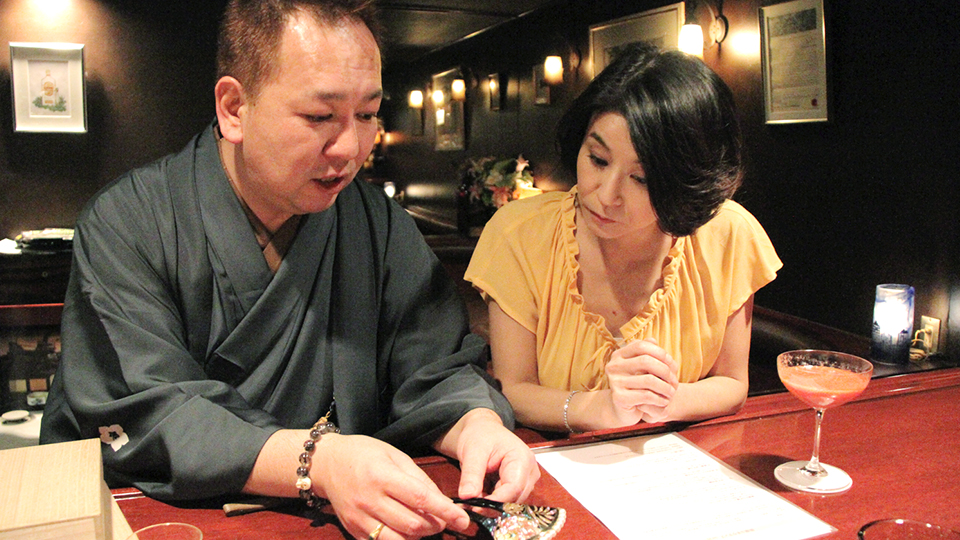
GINZA CONNECTIVE VOL.20
Koji Shibata×Chisako Takashima
2013.05.01
A talk series with the violinist Chisako Takashima and the Ginza people. Ginza holds many personal and professional memories for Takashima. In this talk series, she thoroughly explores various aspects of the Ginza culture with her guests. Today’s guest is Koji Shibata, the third generation owner of Ginza-Kanameya, a kimono accessories shop that has been operating since the early Showa period.
When it comes to refined tortoiseshell accessories, there is no match for Edo-bekko.
- Takashima
- By the way, around when did tortoiseshell crafting begin?
- Shibata
- Although there is no clear literature on that point, it is said that the craft originated in China in the 6th century. Around that time (the Asuka and Nara periods), biwa lutes, walking sticks and other artifacts made with tortoiseshell were supposedly brought to Japan as well and are kept in the Todaiji temple Shoso-in treasure repository. Tortoiseshell crafting was not brought to Japan until some time later, around the Edo period. During the period of national isolation enforced by the Tokugawa shogunate, the crafting that had been brought from China to Portugal was then supposedly brought to Japan as well by Portuguese traders arriving by ship in Nagasaki, Japan’s foreign trade port at the time. In that sense, Nagasaki is considered the origin of tortoiseshell crafting. Then, perhaps because of Japanese national disposition coupled with innate manual dexterity, the tortoiseshell crafting was further refined in Japan towards the creation of aesthetic products like artistic ornaments and Western clothing accessories. The tortoiseshell crafting skills that were brought to Nagasaki were made increasingly more precise and moved gradually eastward, with the eventual budding of skills for processing hairpin and other ornaments with tortoiseshell materials in the inner palace of Edo castle. That is why Edo (Tokyo) is the true center for tortoiseshell ornamental hairpins, obi ornaments, and other kimono accessories.
- Takashima
- So, it’s actually relatively new. And also surprising, because you would think that Kyoto would be the center for tortoiseshell products.
- Shibata
- Yes, customers often ask me if tortoiseshell ornamental hairpins and accessories should be bought in Kyoto, but, as I said, it’s actually Tokyo that was and still is the largest producer of ornamental hairpins, obi ornaments, and other tortoiseshell products related to Japanese tradition. Of course they are also made in other regions as well (like Kyoto, Osaka, and Nagasaki), but Tokyo was especially the best place for traditional Japanese tortoiseshell accessories in the Edo period, and remains so today.
- Takashima
- Hence the name Eddo-bekko.
- Shibata
- Yes. As evidence, the City of Tokyo has properly certified it as a traditional craft of Tokyo.
- Takashima
- What species of turtle is used for tortoiseshell?
- Shibata
- The hawksbill turtle that is a type of sea turtle. I don’t know if this is still the case, but in the past the turtles were used as food in Cuba. Tortoiseshells were the empty shells left over.
- Takashima
- But isn’t hawksbill turtle import banned under the Washington Convention?
- Shibata
- Yes, it is. So now we process bit by bit the stock that was brought to Japan before the import ban (import was banned in 1992). There is concern that, Japan’s stock will eventually run out if the import ban is not lifted. But right now there is a greater fear that we will run out of tortoiseshell craftspeople even before we reach the bottom of our stock. When either happens, the irreplaceable and invaluable traditional Japanese craft and culture that has been carefully passed down from generation to generation since the Edo period will come to an end.
- Takashima
- How many craftspeople do you work with now?
- Shibata
- They do not work exclusively for Kanameya, but we have about 20 to 30 craftspeople working for us. Most of them are seniors.
- Takashima
- So procuring materials and training craftspeople are both difficult right now. Still, I want this wonderful piece of Japanese culture to be passed down to future generations.
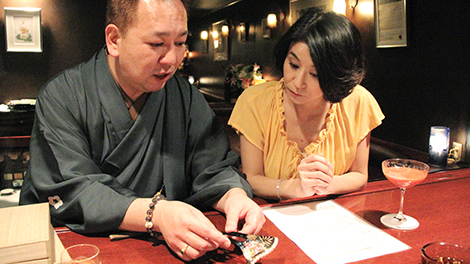
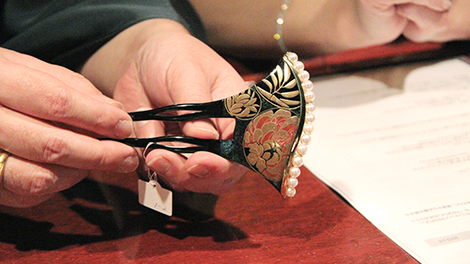
I want people to be impressed by their visit to Ginza.
- Takashima
- How would you like Ginza to be in the future?
- Shibata
- Well first of all, it’s no exaggeration to call Ginza the number one shopping district in Japan. I want it to stay that way in the future as well. At the same time, I also want it to be a safe area. You can often see parents walking through Ginza with their kids even at night. It’s not a sight you generally see in other bustling shopping districts. It just shows how keenly the people of Ginza keep watch.
- Takashima
- That is certainly true.
- Shibata
- Above everything, I want people to be impressed by their visit to Ginza. Whether shopping or food, I want Ginza to live up to its expectations so that visitors are pleased and think, “Only in Ginza.” To make that happen, each and every shop and person running a business in Ginza needs to be constantly devising and offering products and services that impress customers. While we are no match for our predecessors who built up Ginza today, I will devote myself to working steadily every day, doing whatever I can.
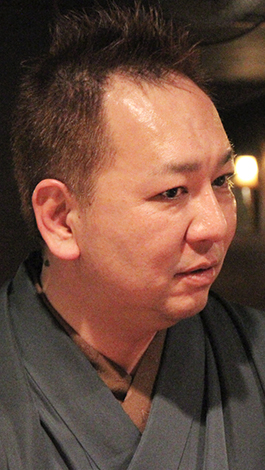
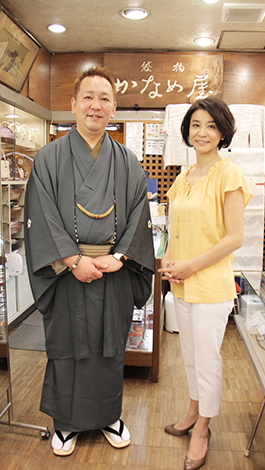
Chisako Takashima
Violinist. Started playing the violin at age 6. After playing abroad, she moved her home base to Japan, and gives concerts all over the country. Although her current focus is on performing music, she also appears on TV and radio programs. Thanks to her much-loved personality, she is appearing in more and more venues.
Chisako Takashima’s official websiteKoji Shibata
President of Ginza-Kanameya, a kimono accessories shop. After graduating from university, he went to study in the United States. He then returned to Japan, and worked at a regular company before becoming the third generation owner of Kanameya. In addition to selling products at his shop, he also conveys the attraction of kimono accessories every day on social networking sites and his blog.
Website of Ginza-KanameyaWriter: Mikiko Okai Interview location: Ginza-Kanameya
1 2
All List
- GINZA CONNECTIVE VOL.0 Ryo Sayegusa×Chisako Takashima
- GINZA CONNECTIVE VOL.1 Toshiyuki Kosaka×Chisako Takashima
- GINZA CONNECTIVE VOL.2 Yasuharu Mizuhara×Chisako Takashima
- GINZA CONNECTIVE VOL.3 Hitoshi Ishihara×Chisako Takashima
- GINZA CONNECTIVE VOL.4 Shinji Hara×Chisako Takashima
- GINZA CONNECTIVE VOL.5 Choichiro Motoyama×Chisako Takashima
- GINZA CONNECTIVE VOL.6 Noriko Okazoe×Chisako Takashima
- GINZA CONNECTIVE VOL.7 Choichiro Motoyama×Chisako Takashima
- GINZA CONNECTIVE VOL.8 Sayuri Yamaguchi×Chisako Takashima
- GINZA CONNECTIVE VOL.9 Yoshiki Tani×Chisako Takashima
- GINZA CONNECTIVE VOL.10 Yoshifumi Itoh×Chisako Takashima
- GINZA CONNECTIVE VOL.11 Kunihiko Miwa×Chisako Takashima
- GINZA CONNECTIVE VOL.12 Shin Watanabe×Chisako Takashima
- GINZA CONNECTIVE VOL.13 Akihiko Tsuda×Chisako Takashima
- GINZA CONNECTIVE VOL.14 Rie Horikawa×Chisako Takashima
- GINZA CONNECTIVE VOL.15 Jun Takahashi×Chisako Takashima
- GINZA CONNECTIVE VOL.16 Yusuke Harada×Chisako Takashima
- GINZA CONNECTIVE VOL.17 Lintaro Mizuhara×Chisako Takashima
- GINZA CONNECTIVE VOL.18 Keisuke Anzai×Chisako Takashima
- GINZA CONNECTIVE VOL.19 Hozu Yamamoto×Chisako Takashima
- GINZA CONNECTIVE VOL.20 Koji Shibata×Chisako Takashima
- GINZA CONNECTIVE VOL.21 Kayo Hosono×Chisako Takashima
- GINZA CONNECTIVE VOL.22 Mitsuru Saito×Chisako Takashima
- GINZA CONNECTIVE VOL.23 Akihisa Kawaguchi×Chisako Takashima
- GINZA CONNECTIVE VOL.24 Mamoru Sugiyama×Chisako Takashima
- GINZA CONNECTIVE VOL.25 Michiaki Kumagai×Chisako Takashima
- GINZA CONNECTIVE VOL.26 Shinichi Tanizawa×Chisako Takashima
- GINZA CONNECTIVE VOL.27 Koichi Suzuki×Chisako Takashima
- GINZA CONNECTIVE VOL.28 Munehito Matsuzaki×Chisako Takashima
- GINZA CONNECTIVE VOL.29 Hiroshi Hara × Chisako Takashima
- GINZA CONNECTIVE VOL.30 Shigeyuki Ando×Chisako Takashima
- GINZA CONNECTIVE VOL.31 Yukichi Ishikura × Chisako Takashima
- GINZA CONNECTIVE VOL.32 Seiko Yamada × Chisako Takashima
- GINZA CONNECTIVE VOL.33 Mami Nagai × Chisako Takashima
- GINZA CONNECTIVE VOL.34 Ryuta Takahashi × Chisako Takashima
- GINZA CONNECTIVE VOL.35 Kazumasa Osumi×Chisako Takashima
- GINZA CONNECTIVE VOL.36 Masahiro Kameoka×Chisako Takashima
- GINZA CONNECTIVE VOL.37 Shoichiro Watanabe×Chisako Takashima
- GINZA CONNECTIVE VOL.38 Keiji Niimoto×Chisako Takashima
- GINZA CONNECTIVE VOL.39 Chieko Nakamura ×Chisako Takashima
- GINZA CONNECTIVE VOL.40 Atsushi Yamane×Chisako Takashima
- GINZA CONNECTIVE VOL.41 Masaya Shibuya×Chisako Takashima
- GINZA CONNECTIVE VOL.42 Makoto Suzuki×Chisako Takashima
- GINZA CONNECTIVE VOL.43 Masaya Konaka×Chisako Takashima
- GINZA CONNECTIVE VOL.44 Masakazu Tanaka×Chisako Takashima
- GINZA CONNECTIVE VOL.45 Koko Kameoka × Chisako Takashima
- GINZA CONNECTIVE VOL.46 Jin Hirayama×Chisako Takashima
- GINZA CONNECTIVE VOL.47 Takashi Hoshihara×Chisako Takashima
- GINZA CONNECTIVE VOL.48 Mikiko Kimura × Chisako Takashima
- GINZA CONNECTIVE VOL.49 Keisuke Okamoto×Chisako Takashima
- GINZA CONNECTIVE VOL.50 Akira Ito × Chisako Takashima
- GINZA CONNECTIVE VOL.51 Tatsuhiko Adachi × Chisako Takashima
- GINZA CONNECTIVE VOL.52 Masahiko Yamano×Chisako Takashima
- GINZA CONNECTIVE VOL.53 Kiyoshi Kanazashi×Chisako Takashima
- GINZA CONNECTIVE VOL.54 Noriyuki Tsuji×Chisako Takashima
- GINZA CONNECTIVE VOL.55 Shoichi Kobayashi×Chisako Takashima
- GINZA CONNECTIVE VOL.56 Isao Nanjo×Chisako Takashima
- GINZA CONNECTIVE VOL.57 Shinobu Mitsuoka×Chisako Takashima
- GINZA CONNECTIVE VOL.58 Motoyoshi Yasuda×Chisako Takashima
- GINZA CONNECTIVE VOL.59 Toru Fujiki×Chisako Takashima
- GINZA CONNECTIVE VOL.60 Yuji Ida×Chisako Takashima
- GINZA CONNECTIVE VOL.61 Hitoshi Miki×Chisako Takashima
- GINZA CONNECTIVE VOL.62 Takehiko Furuya× Chisako Takashima
- GINZA CONNECTIVE VOL.63 Naoki Yoshizawa×Yusuke Yoshizawa×Chisako Takashima
- GINZA CONNECTIVE VOL.64 Kazuhito Kawase × Chisako Takashima
- GINZA CONNECTIVE VOL.65 Toshiji Yuki× Chisako Takashima
- GINZA CONNECTIVE VOL.66 Hikoyuki Yamaguchi×Chisako Takashima
- GINZA CONNECTIVE VOL.67 Daisuke Nagano×Chisako Takashima
- GINZA CONNECTIVE VOL.68 Shuichi Motohashi× Chisako Takashima
- GINZA CONNECTIVE VOL.69 Shinpei Tonaka×Chisako Takashima
- GINZA CONNECTIVE VOL.70 Shinya Kanematsu × Sachiko Takashima
- GINZA CONNECTIVE VOL.71 Masataka Yano×Chisako Takashima
- GINZA CONNECTIVE VOL.72 Mitsuhiro Kurokawa× Chisako Takashima
- GINZA CONNECTIVE VOL.73 Ryo Saegusa×Chisako Takashima








